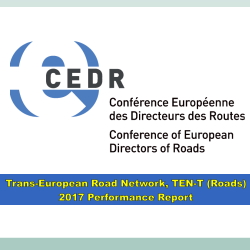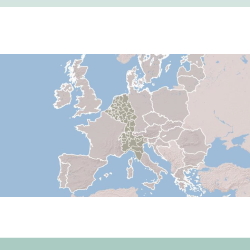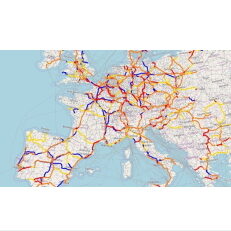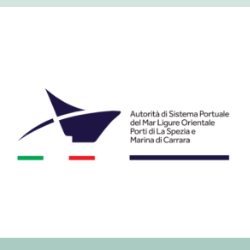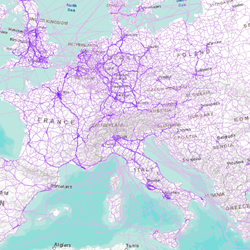- All
- African projects
- assessment
- assessment selected projects
- Assessment selected projects 2
- Assessment selected projects 3
- Assessment selected projects 4
- ASTRA
- Cost Benefit Analysis
- Electric mobility and ITS
- MOMOS
- planning
- planning selected projects
- planning selected projects 2
- planning selected projects 3
- planning selected projects 4
- planning selected projects 5
- projects
- Railways projects
- research
- research selected projects
- research selected projects 2
- research selected projects 3
- studies
- studies selected projects 1
- studies selected projects 2
- studies selected projects 3
- studies selected projects 4
- studies selected projects 5
- TRTingegneria
- TRUST
- urban mobility
- The Impact Assessment study, developed for the European Commission, aims to identify and assess the impacts of policy measures on facilitating the deployment of multimodal ITS services By enabling communication between vehicles, infrastructure and other road users, Cooperative Intelligent Transport Systems (C-ITS) can greatly improve safety and efficiency in road transport. Here is a look at some of the most recent developments in C-ITS and how quickly the technology could change the way we drive and interact with each other in traffic. The wide-scale deployment of Cooperative Intelligent Transport Systems could contribute to delivering several Commission’s objectives for transport, such as those on safety, reduced congestion, enhanced mobility and environmental performance. Together with Ricardo Energy&Environment, TRT supported the Directorate for Mobility and Transport of the European Commission in three different studies over a six year period. In 2020-2021 for the development of an Impact Assessment Support Study for the revision of the Intelligent Transport Systems Directive (2010/40/EU) to support the EC with evidence-based analysis. In 2017-2018 developing the legal framework required to support the widespread deployment of C-ITS services in Europe by 2019: a set of policy options and deployment scenarios were assessed with the European scale modelling tools ASTRA and TRUST for the analysis and comparison of the impacts in terms of economic, environmental and social indicators. In 2015 for the preparation of the Communication strategy and the Action plan for the deployment of C-ITS in Europe, providing the analysis of costs and potential benefits based on different scenarios. To support the analysis, the ASTRA and TRUST models are applied to provide quantitative indicators to evaluate the impacts of various policy options and deployment scenarios. For more information Final report of 2015 study Final report of 2017-2018 study
- Odometer tampering – measures to prevent it (Research for TRAN Committee) The study, commissioned by the TRAN Committee of the EU Parliament, examined the phenomenon of odometer tampering in the EU and proposed concrete actions to tackle it. Despite the EU legislation has addressed the issue in the “Roadworthiness Package”, a major gap has been identified in the long timeframe occurring between the vehicle’s registration and the first Periodical Technical Inspection, as well as the lack of sufficient cooperation and data exchange on odometer readings between EU Member States (MS). The implementation of a EU-wide data exchange system between EU MS on odometer readings could help competent authorities to detect fraudsters (as shown by the Slovakian and the Dutch bilateral cooperation, making use of the EUCARIS platform). The study also explored the best practices developed in Belgium and the Netherlands, where the problem was nearly eradicated in the last years. In both countries the percentage of unauthorised manipulations dropped below 1%. Furthermore, the study highlighted that odometers are still inadequately protected against cybersecurity threats. Potential IT solutions to combat the phenomenon have been suggested. [tw_button icon=”” link=”https://www.trt.it/archivio-progetti/” size=”small” rounded=”false” style=”flat” hover=”default” color=”#223468″ target=”_self”]Projects[/tw_button]
- CEDR’s TEN-T (Roads) 2017 Performance Report The 2017 TEN-T (Roads) Performance report is the fifth biannual report issued by the Conference of European Directors of Roads (CEDR) on the performance of the TEN-T road network within the participating countries. Biennial CEDR reports offer a coherent set of data with which to monitor trends and identify changes in the performance of the TEN-T road network since the year 2009. As such, these reports are a particularly useful source of information for individual National Road Authorities, regulatory bodies and others for benchmarking purposes and for setting national performance targets. More specifically, the CEDR reporting framework is based on a common simple Location Referencing Model and a consistent set of performance indicators based on common data definitions and on data provided directly by National Road Administrations. A web map is developed to display the GIS layer of CEDR’s logical network, in conformity with CEDR’s Location Referencing Model, and to allow for the visualisation of thematic maps showing road performance indicators at link level (e.g. road type, number of lanes, etc.) and for different years. An online tool is developed for the collection and visualization of CEDR Strategic Key Performance Indicators. For more information, please check the project website – cedr.eu
- Transport Market Study: Quantification of modal shift potential on the Rail Freight Corridor Rhine-Alpine The study, coordinated by TRT and involving relevant partners across Europe, aimed to quantify the potential modal shift to rail thanks to the improvement in transport performance on the Rail Freight Corridor Rhine-Alpine. More specifically, the objective of the study was to investigate the possibility to introduce: heavier and longer trains, faster trains (less stops), more reliable trains. The work was structured by three consecutive activities: analysis of the freight transport demand, quantification of the cost savings in relation to heavier, faster and more reliable trains, quantification of modal shift potential. For more information The Transport Market Study summary report is available for download here
- Sustainable Transport Infrastructure Charging and Internalisation of Transport Externalities The objective of the study was to assess the extent to which the “user pays” and the “polluter pays” principles were implemented. This allowed the European Commission to take stock of the progress of Member States towards the goal of full internalisation of external and infrastructure costs of transport and to identify options for further internalisation. The scope of the study involved all external costs, all transport modes and, geographically, EU28 plus Norway, Switzerland, USA (2 States), Canada (2 provinces) and Japan. To realise the general objective and address the scope of the study information has been collected extensively about: infrastructure costs (i.e., investment, renewal and operating), transport-related charges, earmarking of fiscal revenues and compensations paid by the users. The analyses carried out in this study showed that the transport taxes and charges levied in the EU Member States are in general insufficient to fully internalise the external and infrastructure costs of transport. For most vehicle categories, only 15% to 25% of the external and infrastructure costs are covered by tax/charge revenues. The cost coverage ratio for passenger cars was found higher (about 50%), which was mainly because of the relatively high fuel and vehicle tax levels applied in (some of) the EU Member States for these vehicles. For inland waterways and maritime transport, much lower cost coverage ratios were found (i.e., 6% and 4%, respectively), reflecting the limited tax/charge burden levied on these modes in the EU. Even if one excludes fixed infrastructure costs from the analyses, the taxes and charges did not cover the external and variable infrastructure costs for most vehicle categories. High-speed trains are an exception, as for these trains the current taxes and charges did cover all external and variable infrastructure costs. This finding has been supported by the results of the analyses of the marginal social cost (MSC) coverage ratios. Despite the limitations of this analyses, it provides a first indication that there was a lack of charging in accordance with the MSC principle in the EU28. The revenues from transport taxes and charges in the EU28 were partly earmarked for expenditure for transport infrastructure. However, significant differences did exist between modes. For road transport, about 10% of the taxes/charges are earmarked, while for rail transport this is about 85%. For the other modes, only fragmented data on earmarking was identified, showing that (at least part of) the (air)port charges are earmarked to cover infrastructure expenditures. Although taxes and charges are efficient policy instruments to reduce the external costs of transport, the study recognize that other types of policy instruments and non-pricing policies (e.g., command-and-control measures and subsidies) may effectively complement tax and charge schemes, for example by providing EU-wide harmonised incentives to invest in certain reduction technologies. With regard to the activities of the study, TRT was responsible to (i) develop estimations of the external costs related to congestion for all transport modes (quantitatively for road), (ii) elaborate estimations of the infrastructure costs […]
- The impact of TEN-T completion on growth, jobs and the environment The objective of the study is to quantify the impact of the TEN-T core network implementation until 2030 – as well as the impact of each of the nine core network corridors separately – on European Union growth, jobs and the environment. The assessment is done with the support of two European scale modelling tools ASTRA and TRUST. ASTRA is a System Dynamics model used for assessing the wider economic impacts like indirect and induced changes in employment or value added and economic growth due to the TEN-T investments. TRUST is a transport network model allowing for the assignment of OD matrices at the NUTS3 level for passenger and freight demand which is used to provide the transport quantitative inputs to ASTRA. A set of major economic, environmental and transport indicators is provided for the assessment at EU level as well as at the level of Member States for the base year 2015 and the time horizons 2020, 2025 and 2030. The quantitative indicators are accompanied by qualitative arguments where required to elaborate on the quality of jobs created and the typology of jobs. For more information The impact of TEN-T completion on growth, jobs and the environment. Go to the publication
- La Spezia – Studio trasportistico del “Nuovo molo Crociere nel primo bacino della Spezia” The mobility analysis of the interventions related to the “New cruise pier in the first basin of La Spezia” drafted by TRT was part of the environmental compatibility verification phase of the Project as “functional technical adaptation” of the PRP of La Spezia port and had the following objectives : evaluate any restrictions or opportunities in the sectorial plans and programs in order to verify the consistency of the proposed interventions or specific problems; estimate the land side traffic produced by the current maritime traffic and expected at two future reference years (2025 and 2035); evaluate the impact in terms of the ratio of traffic to capacity, both at local and at regional level. The planning framework was also verified, in relation to the proposed interventions location, the planning tools as well as the traffic forecasts of the cruise pier contained in the previous study developed by TRT through an adjustment of traffic forecasts both sea side and land side. Finally, the traffic impact analysis was carried out. [tw_button icon=”” link=”https://www.trt.it/archivio-progetti/” size=”small” rounded=”false” style=”flat” hover=”default” color=”#223468″ target=”_self”]Projects[/tw_button]
- Parking Master Plan of the city of Prato, Italy TRT drafted the Parking Master Plan of the city of Prato (Italy), a plan that intended to meet the needs of both the Municipal Administration and Consiag Servizi Comuni, the parking system manager in the city of Prato. The thematic analysis was developed after the preparation of the Sustainable Urban Mobility Plan (SUMP) and was contextual to the preparation of the Urban Traffic Plan. On-field activities (developed in the initial phase of the work) involved a wide street survey meant to gain precise knowledge on parking supply and demand of parking spaces. The Parking Master Plan, in addition to the provision of parking supply sizing for different areas of the city: identifies the most rational mix of parking regulation and pricing policies for each city district; modulates the parking tariffs on the basis of the urban characteristics of Prato; optimizes the multi-level garage system, encourages the use of parking spaces outside the city center as well as sets up a network of Park&Ride parkings.
- Impact assessment accompanying the revision of Eurovignette Directive for Heavy Goods Vehicles charging The “Eurovignette” Directive provides a detailed legal framework for charging heavy goods vehicles (HGVs) for the use of certain roads. Following ex-post evaluations of the current legislative framework, the Commission intends to assess the potential impacts of options for a possible revision of the legislative act. The impact assessment study will help substantiate the specific problems linked to charging of vehicles and to design policy options in this field. TRT supports the quantitatve assessment of the impacts of the policy options through the use of European scale models ASTRA and TRUST.



